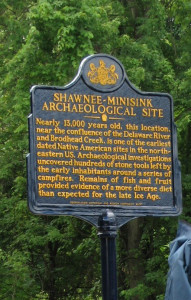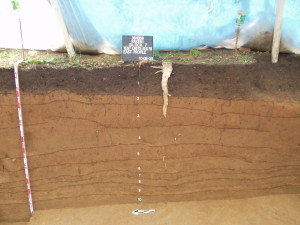The U. S. Department of the Interior, National Park Service, describes the National Register of Historic Places as “the official list of districts, sites, buildings, structures, and objects significant in American history, architecture, archeology, engineering, and culture. National Register properties have significance to the prehistory or history of their community, State, or the Nation (NPS 1990, revised 1997).
But the National Register is not necessarily just a list of the most important sites in the country; rather, it is also a management tool—at least in my way of thinking. Under federal regulations that implement Section 106 of the National Historic Preservation Act, federal agencies are obligated to consider whether projects they fund, permit or license will adversely affect any sites, buildings, districts, etc. that are listed in or eligible for listing in the National Register. The tool for evaluation of these properties is the set of National Register criteria. For a property to be eligible for the National Register, it must meet one or more of these criteria.
These criteria include: Criterion A, association with an event or a pattern of events important in American prehistory or history; Criterion B, association with specific individuals who are considered important in our nation’s past; Criterion C, importance for architecture, engineering or artistic merit; and Criterion D, potential to yield important information. Under Criterion D, the property must provide information that is important to our understanding of American prehistory or history. In short, the criteria are event (A), person (B), design/construction(C) and information potential (D).
Criterion D, is the criterion by which most archaeological sites are judged. But this evaluation can’t be made in a vacuum. To have information potential, a site must be able to help answer a set of questions asked of the data.
 For example, the site data may have potential to indicate whether the people who lived there did so on a permanent basis or only in certain seasons. As another example, a site may have potential to provide dates on otherwise poorly dated artifacts through radiocarbon dating of preserved organic remains. As yet another example, an 18th century site that contains archaeological remains of the dwellings of tenant farmers, servants or slaves may have potential to tell us about the servants’ living conditions, their food ways, their access to commercial goods and, perhaps, their level of autonomy. Excavation and analyses of some historical archaeological sites have also provided information that supplemented or—in some cases–debunked information found in the historical accounts.
For example, the site data may have potential to indicate whether the people who lived there did so on a permanent basis or only in certain seasons. As another example, a site may have potential to provide dates on otherwise poorly dated artifacts through radiocarbon dating of preserved organic remains. As yet another example, an 18th century site that contains archaeological remains of the dwellings of tenant farmers, servants or slaves may have potential to tell us about the servants’ living conditions, their food ways, their access to commercial goods and, perhaps, their level of autonomy. Excavation and analyses of some historical archaeological sites have also provided information that supplemented or—in some cases–debunked information found in the historical accounts.
In all of these examples, there should be explicit historic contexts in which the research questions are posed. Such contexts are based on historical research, syntheses of information from similar sites, previous regional studies and gaps in the current information.
In order to have potential to answer questions posed, the site also must show some “integrity”. In other words, the site’s physical conditions must not be so badly disturbed that the material remains have been moved about (or even partly removed) to the point that the patterns and associations once present on the site cannot be identified.
One example of a prehistoric site with integrity would be one of a 4,000-year old Native hunters and gathering camp in which there are separated artifact clusters of the same time period, where the artifact types appear to have been used for different purposes from one cluster to another. For example, one area of the site may contain pottery and grinding stones indicating food preparation, while another area may contain only incomplete stone tools and waste flakes from working the stone. Study of the patterns formed by these distinct artifact groups can establish how people used different parts of the site and what their work areas and community patterns looked like.
A site may have what archaeologists refer to as “features”. These can include pits, cellars, hearths/cooking features, evidence of structures and so forth. One thing that makes these features a valuable part of the data set is that they usually represent fixed points in time, without the background noise and mixing of unrelated materials from different time frames.
A site may be “stratified,” meaning that remains of earlier time periods are sealed off beneath later ones. In such cases, each layer can be analyzed independent of the overlying and underlying ones. Study of a stratified site can help establish how people used the site over time and how artifact styles and types changed. This independent analysis is only successful if there is stratification and separation of the time periods, as opposed to deposits that have become collapsed and mixed so that the time periods cannot be pulled apart and observed separately.
Although most archaeological sites are found eligible for the National Register under Criterion D, some can be eligible under additional criteria. As an example, we’ll use the site of Fort Augusta, a substantial French and Indian War fort in what is now the community of Sunbury. Past excavations there have demonstrated that the site has some remaining archaeological integrity and information potential, even though parts have been compromised by later construction and other disturbances. But an argument can also be made for the site’s eligibility under Criterion A. The archaeological remains are confirmed as those of the fort, and the fort itself was associated with events important in both regional and national history.
An example of an archaeological site that, in my opinion, could be eligible under as many as three criteria, is the “President’s House” in the City of Philadelphia. The former house was briefly occupied by the British during the Revolutionary War and, from 1790 to 1797; it was used as the equivalent of what is now the White House by George Washington. The site is well known in the present-day Philadelphia community surrounding it, because Washington had kept nine slaves there. The public excavation and outdoor exhibit since erected there have made for intense dialogue regarding race relations in the United States both now and in the past.
The Presidents House project was conducted by the City of Philadelphia and the National Park Service as an important public outreach project; it was not a project done for compliance with Section 106 of the National Historic Preservation Act. Consequently, a National Register evaluation was unnecessary in the context of the excavation program that was conducted.
Would this site be eligible for the National Register? I think this is a no-brainer. But under what criteria would it be judged? To my way of thinking, the appropriate criteria would be as follows:
For Criterion D, the site did prove to have substantial information important to our understanding of American history, and the ground plan of the site and its associated facilities was exposed and interpreted for the public during the excavation. But I would also argue for criteria A and B. Using Criterion A, would this site be important for its association with significant events in American history? Given the role of the site in the American Revolution and the first presidential administration, this one seems obvious to me.
And what about Criterion B, association with persons important in American history? I would say yes: George Washington actually did sleep here (as well as serve as the first President of the United States here!)
Reference:
1990 How to Apply the National Register Criteria for Evaluation. U.S. National Park Service, revised 1997.


0 Comments
1 Pingback